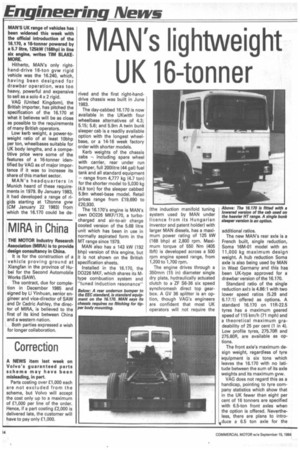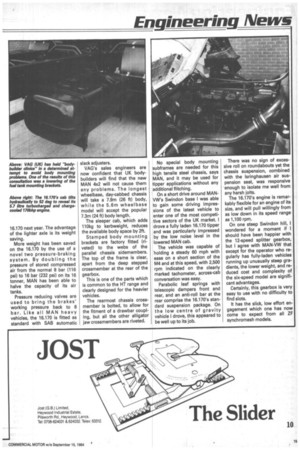MAN's lightweight UK 16-tonner
Page 16

Page 17

If you've noticed an error in this article please click here to report it so we can fix it.
MAN'S UK range of vehicles has been widened this week with the official introduction of the 16.170, a 16-tonner powered by a 5.7 litre, 125kW (168hp) in line six engine, writes TIM BLAKE. MORE.
Hitherto, MAN's only righthand-drive 16-ton gvw rigid vehicle was the 16.240, which, having been designed for drawbar operation, was too heavy, powerful and expensive to sell as a solo 4 x 2 rigid.
VAG (United Kingdom), the British importer, has pitched the specification of the 16.170 at what it believes will be as close as possible to the requirements of many British operators.
Low kerb weight, a power-toweight ratio of at least 10bhp per ton, wheelbases suitable for UK body lengths, and a competitive price were some of the features of a 16-tonner identified by VAG as of major importance if it was to increase its share of this market sector.
MAN's headquarters in Munich heard of these requirements in 1979. By January 1983, it had developed a range of rigids starting at 12tonne gvw (CM January 22 1983) from which the 16.170 could be de rived and the first right-handdrive chassis was built in June 1983.
The day-cabbed 16.170 is now available in the UKwith four wheelbase alternatives of 4.3; 5.15; 5.6; and 5.9m A twin bunk sleeper cab is a readily available option with the longest wheelbase, or a 14-16 week factory order with shorter models.
Kerb weights of the chassis cabs including spare wheel with carrier, rear under run bumper, full 200litre (44 gal) fuel tank and all standard equipment — range from 4,777 kg (4.7 ton) for the shorter model to 5,030 kg (4.9 ton) for the sleeper cabbed 5.9m wheel-base model. Retail prices range from £19,690 to £20,930.
The 16.170's engine is MAN's own D0226 MKF/170, a turbocharged and air-to-air charge cooled version of the 5.68 litre unit which has been in use in normally aspirated form in the MT range since 1979.
MAN also has a 143 kW (192 bhp) version of this engine, but it is not shown on the British specification sheets.
Installed in the 16.170, the D0226 MKF, which shares its Mtype combustion system and "tuned induction resonance" (the induction manifold tuning system used by MAN under licence from its Hungarian inventor and patent holder) with larger MAN diesels, has a maximum power rating of 125 kW (168 bhp) at 2,800 rpm. Maximum torque of 550 Nm (405 Ibft) is developed across a 500 rpm engine speed range, from 1,200 to 1,700 rpm.
The engine drives through a 350mm (15 in) diameter single dry plate, hydraulically actuated clutch to a ZF S6-36 six speed synchromesh direct top gearbox. A GV 36 splitter is an option, though VAG's engineers are confident that most UK operators will not require the additional ratios.
The new MAN's rear axle is a French built, single reduction, Soma 16M-01 model with an 11,000 kg maximum design weight. A hub reduction Soma axle is also being used by MAN in West Germany and this has been UK-type approved for a drawbar version of the 16.170.
Standard ratio. of the single reduction ax1.1 is 4.86:1 with two lower speed ratios (5.29 and 6.17:1) offered as options. A standard 16.170 on 11R-22.5 tyres has a maximum geared speed of 115 km/h (71 mph) and a theoretical maximum gradeability of 25 per cent (1 in 4). Low profile tyres, 275.70R and 275.80R, are available as options.
The front axle's maximum design weight, regardless of tyre 'equipment is six tons which leaves the 16.170 with no latitude between the sum of its axle weights and its maximum gvw.
VAG does not regard this as a handicap, pointing to tyre company statistics which show that in the UK fewer than eight per cent of 16 tonners are specified with 6.5-ton front axles when the option is offered. Nevertheless, there are plans to introI. duce a 6.5 ton axle for the
16.170 next year. The advantage of the lighter axle is its weight saving.
More weight has been saved on the 16.170 by the use of a novel two pressure-braking system. By doubling the pressure of stored compressed air from the normal 8 bar (116 psi) to 16 bar (232 psi) on its 16 tonner, MAN has been able to halve the capacity of its air tanks.
Pressure reducing valves are used to bring the brakes' working pressure back to 8 bar. Like all MAN heavy vehicles, the 16.170 is fitted as standard with SAB automatic slack adjusters.
VAG's sales engineers are now confident that UK bodybuilders will find that the new MAN 4x2 will not cause them any problems. The longest wheelbase, day-cabbed chassis will take a 7.9m (26 ft) body, while the 5.6m wheelbase model will accept the popular 7.3m (24 ft) body length.
The sleeper cab, which adds 110k9 to kerbweight, reduces the available body space by 2ft.
Stamped body mounting brackets are factory fitted (riveted) to the webs of the parallel chassis sidemembers. The top of the frame is clear, apart from the deep stepped crossmember at the rear of the gearbox.
This is one of the parts which is common to the HT range and clearly designed for the heavier vehicles.
The rearmost chassis crossmember is bolted, to allow for the fitment of a drawbar coupling, but all the other alligator jaw crossmembers are riveted. No special body mounting subframes are needed for this high tensile steel chassis, says MAN, and it may be used for tipper applications without any additional flitching.
On a short drive around MANVW's Swindon base I was able to gain some driving impressions of the latest vehicle to enter one of the most competitive sectors of the UK market. I drove a fully laden 16.170 tipper and was particularly impressed by the low noise level in the lowered MAN cab.
The vehicle was capable of holding a steady 60 mph with ease on a short section of the M4 and at this speed, with 2,500 rpm indicated on the clearly marked tachometer, across-cab conversation was easy.
Parabolic leaf springs with telescopic dampers front and rear, and an anti-roll bar at the rear comprise the 16.170's standard suspension package. On the low centre of gravity vehicle I drove, this appeared to be well up to its job. There was no sign of excessive roll on roundabouts yet the chassis suspension, combined with the lsringhausen air suspension seat, was responsive enough to isolate me well from any harsh jolts.
The 16.170's engine is remarkably flexible for an engine of its size, and will pull willingly from as low down in its speed range as 1,100 rpm.
On one steep Swindon hill, I wondered for a moment if I should have been happier with the 12-speed splitter gearbox, but I agree with MAN-VW that except for the operator who regularly has fully-laden vehicles running up unusually steep gradients, the lower weight, and reduced cost and complexity of the six-speed model are significant advantages.
Certainly, this gearbox is very easy to use with no difficulty to find slots.
It has the slick, low effort engagement which one has now come to expect from all ZF synchromesh models.






























































































